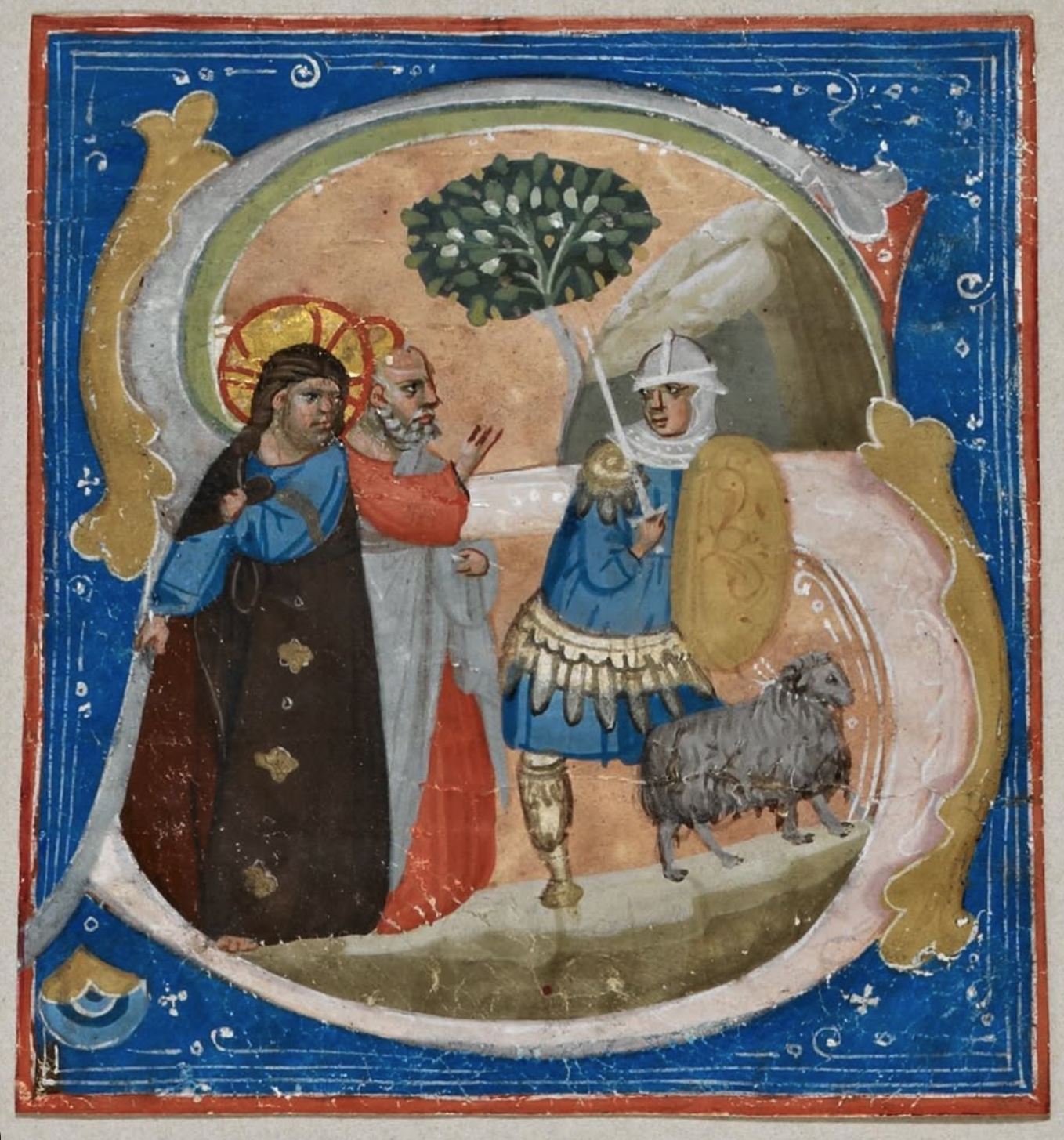A Certain Hand: Recognizing Nerio in a Fragmented World
Among the early 14th-century illuminators working in Bologna, Nerio stands out for his distinctive visual language firmly rooted in Byzantine traditions yet strikingly responsive to Giotto’s revolutionary naturalism. For these reasons, he has long been one of my favorite early Italian painters. One antiphonal leaf recently added to my collection exemplifies his brilliance. Painted within a monumental initial “A,” the scene depicts two kneeling martyrs moments before execution, accompanied by the antiphon Absterget Deus omnem lacrimam ab oculis eorum (“And God shall wipe away all tears from their eyes,” Revelation 21:4), sung at Matins during the Feast of the Common of Many Martyrs.
1. Nerio, The Martyrdom of the Faithful, Italy, likely Bologna,, c. 1310–1330
The sheer scale of the folio and refinement of its composition suggest that it was part of a lavish, multi-volume choir book likely commissioned for a Dominican or Franciscan house in Bologna between 1310 and 1330. Few such leaves remain intact today. Most Nerio miniatures survive as isolated cuttings, dispersed in the 19th century and absorbed into albums or frames. The rarity of a full leaf makes this one particularly significant.
2. Detail, Nerio, The Martyrdom of the Faithful, Italy, likely Bologna,, c. 1310–1330
What struck me immediately was its connection to a group of Nerio miniatures held in British institutions, namely the British Library, the Victoria & Albert Museum, and the Fitzwilliam Museum in Cambridge, as well as a leaf formerly in the Zeileis Collection, sold at Koller in 2015. While it remains uncertain whether all these fragments originated from the same antiphonary, their stylistic and compositional parallels are unmistakable.
This leaf is related to a small group of fragments attributed to Nerio. Together, they offer an increasingly coherent picture of a now-lost cycle. The following miniatures are among the most securely connected to the Martyrdom leaf above.
British Library, Add. MS 32058, f. 2(a) – Scenes from the Life of Christ, including nearly identical solider figure in foreground and tree in background
Fitzwilliam Museum, Marlay Cutting It. 80b – The Martyrdom of St. Lucy, with a nearly identical sword-bearing executioner.
Fitzwilliam Museum, Marlay Cutting It. 80c – The Martyrdom of St. Stephen, almost identical so bearded male figure striking martyr.
Victoria & Albert Museum, 9024D and 9024E – Isaac sending Esau and Abraham in Prayer, pairs of white dotting on red outline of halos.
Former Zeileis Collection, sold at Koller (2015) – The Calling of Andrew and Peter, with similarly innovative frontal poses, which is also present in British Library, Add., MS 32058 f. 2(b).
Nerio, Scenes from the Life of Christ
British Library, Add. MS 32058, f. 2(a)
These soldiers have very distinctive attire. They share identical armor, chain mail skirting and hoods. The striking blue color of their tunics are well defined.
Nerio, the Martyrdom of St. Lucy
Fitzwilliam Museum, Marlay Cutting It. 80b
Here again, the same, a near identical soldier in a more dynamic pose ready to strike.
Nero, Martyrdom of St. Stephen
Fitzwilliam Museum, Marlay Cutting It. 80c
A near identical figure that is reused again as an executioner.
Nerio, Calling of the first Apostles Andrew and Peter
ex-Zeileis Collection, sold at Koller, Zurich, lot 141, Sept. 18 2015
The forward-facing figures are very bold. Nerio is thinking out of the box!
Nerio, Abraham in Prayer
Victoria & Albert Museum, 9024D and 9024E
Nerio, Isaac sending Esau
Victoria & Albert Museum, 9024D and 9024E
A particularly distinctive feature found on several of these cuttings is the use of white dotting on the red outlines of the gold halos. This small yet highly specific detail appears across multiple fragments, strengthening the attribution to Nerio.
Much remains to be learned. I plan to visit the V&A this later this year to compare stave measurements, in hopes of clarifying whether these fragments once belonged to the same multi-volume choir book. Until then, I offer this post as an invitation to look closely, to consider these leaves not as isolated survivors but as fragments of a once-cohesive artistic and devotional whole.
I am very grateful to Gaudenz Freuler for his kind help with this attribution.













